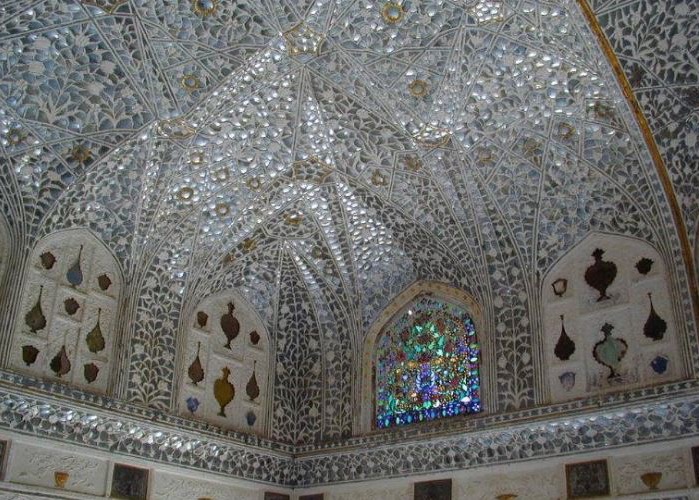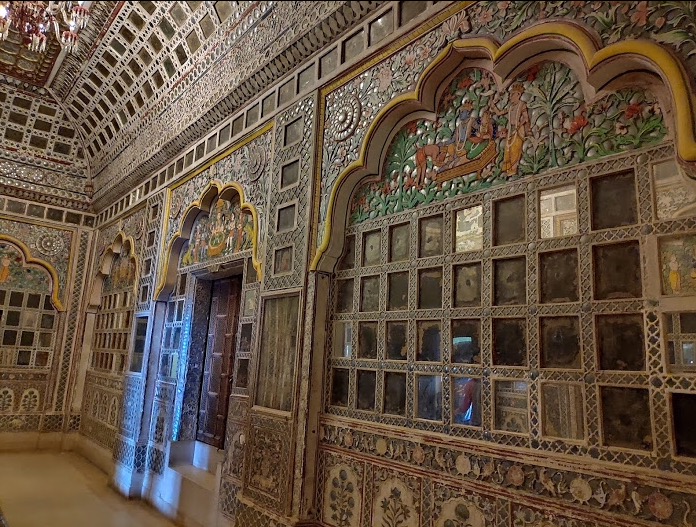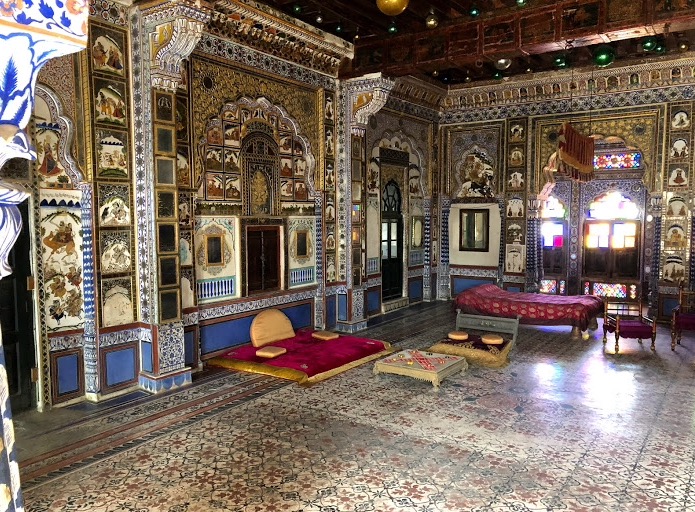Cover Story
The Sheesh Mahals of Rajasthan

Explore the majestic folk art of Rajasthan in the form of intricate mirror-work structures of the Sheesh Mahals
ByShona Adhikari
February 29, 2020 (IANSlife) Mirror-work has traditionally played a very important role in decor of all kinds and Rajasthan and Gujarat, can be credited with introducing the world to innovative methods of using mirrors.
The urge for decoration permeates all facets of life in Rajasthan and Gujarat and it was initially used to decorate homes. In fact, the mirror was first used as an embellishment on the exterior walls - embedded in mud walls these mirrors were usually small and circular in shape and the patterns in white chalk white around them huts very attractive.
This type of work can still be seen in remote villages in Gujarat and Rajasthan. Mirrors as wall décor was probably introduced by traders, arriving over land and sea, from Europe and Persia.
The use of mirrors in garments is now universally known, and designers of high fashion garments the world over have been experimenting with mirror work for the past decade.
However, the intricate mirror work used in decorating walls, such as the hall of mirrors or "Sheesh Mahal" at the Amber Fort in Jaipur, is less widely known. Awed by the ornate palaces in Rajasthan, I have often marveled at the mirror work that one sees covering the walls of palaces. These ‘Sheesh Mahal’s’ are seen at most of the famous palaces and havelis in Rajasthan. Some of the finest examples of this work can be seen on the ceilings, walls and columns of the palace at Samode, the Diwan-e-khas at Amber, the City Palace and Lake Palace at Udaipur, the Mehrangarh Fort in Jodhpur and the Junagarh Fort at Bikaner.

Traditionally, mirror work and "panni" work - which is the use of coloured foil to fill in or outline the
designs - were used together. The foil helps in giving each pattern a clear and well-defined outline,
and highlights the visual impact of the overall design. Stained glass windows in primary colours set in geometrical designs, in conjunction with mirror and panni work has been used extensively in the
interiors of fifteenth century forts, palaces and havelis" of Rajasthan.
The use of myriad mirrors began with the decoration and embellishment of temples. Mirror-workers involved in this craft for 6 generations, say that the purpose of multiple mirrors, was to
create endless images of the deities - showing that God was omnipresent.
To the commoner, the Maharaja was also considered if not at the level of God, but certainly as an exalted being whose royal visage deserved to be enhanced!
It is also likely that this folk art, seen and appreciated by-the feudal lords of Rajasthan, who decided
to decorate their palaces with a more highly developed and sophisticated version. In this, the Rajas
and Maharajas found that walls covered in mirror work, multiplied the images of lamps - making the
room brighter.

Vanity also played a large part in this, as the personage of the Maharaja was also multiplied! Hence throne rooms, halls of private and public audience and other special areas, were heavily decorated with mirror work, interspersed with moulded gilding and panni work.
Needless to say, the royal harems were also mirror bedecked, so that the monarch would be able to
see multiple images of his favourite queen. It is said that the use of large mirrors on garments by the
nomadic Rabari tribe of Rajasthan, also had its origin in the fact that the male wished to be reflected
in the garments of his beloved!
As expected in specialized creativity, mirror work is a highly intricate process that requires great skills
learnt from a young age. The craftsmen who are involved in this work are usually descendants of
families who have been in this trade for generations. In addition to skill, a great deal of patience and
perseverance is required, since a craftsman can only complete a tiny portion of the work in a day.
The mirrors used in this type of work, may be plain or coloured, and traditionally these were made in
Faizabad and Ahmedabad. Usually available in circular shapes of 30cm diameter, and 2-4 mm
thickness - a thicker gauge makes cutting difficult, while a thinner gauge makes them easily
breakable. Conclave mirrors reflected a larger spectrum of images and were used during Mughal
times.
The mirrors are placed on a base of lime plaster, watered for several days, and made rough to
prevent cracks. A special paste formed by mixing kali(baked lime) and surkhi (crushed burnt brick)
with water is applied before the relief work. The design is carved with a 20-23 cm long kalam which
has a pointed upper tip for carving, and a flat lower tip for scraping off undesired paste.

The mirrors are cut into the desired shape, and their edges softened with another 15 cm. "Kalam" with teeth-like edges. A 10 cm long "chimti" then comes into play, and the mirrors are painstakingly placed piece by piece to form the design.
Panni work is done with thin foil, available in many colours. The technique involves outlining the
floral designs on a glass surface, cutting it out with scissors, and then rubbing it with a hard stone (
known as "hakkik ka pathar") to create a concave surface. It is then placed on the outlined design,
and attached with a special paste made out of a combination of baked clay, gum and water. The
glass is framed in lime plaster with a slight gap between it and the wall.
The overall effect is not only three-dimensional, but also catches the light of the sun or a lamp, and reflects it with total clarity.
This is an elaborate and time-consuming art requiring great skill and precision. Combined with the
expense involved, and changing styles, it has naturally resulted in considerable loss of patronage.
Today there are only about a handful of craftsmen in Rajasthan who have the knowledge of this
technique. It is hoped that in time to come, patrons for this exquisite craft will come forward, to
offer opportunities to recreate the magical world of mirrors. This decorative work was used
extensively on furniture, beds, stools and baby cribs or "jhulas" – and in days gone by, was perhaps a comparatively inexpensive style of ornamentation.
For the few existing mirror – workers, their livelihood depends on the urban use of their craft. They
normally live in groups, and whole families may work together, so that progress is faster. As in the
case of all Indian crafts, the art of mirror-work is handed down from father to son, and training
imparted on site.

(This article is a website exclusive and cannot be reproduced without permission of IANSlife)
Shona Adhikari is a lifestyle and travel columnist.


